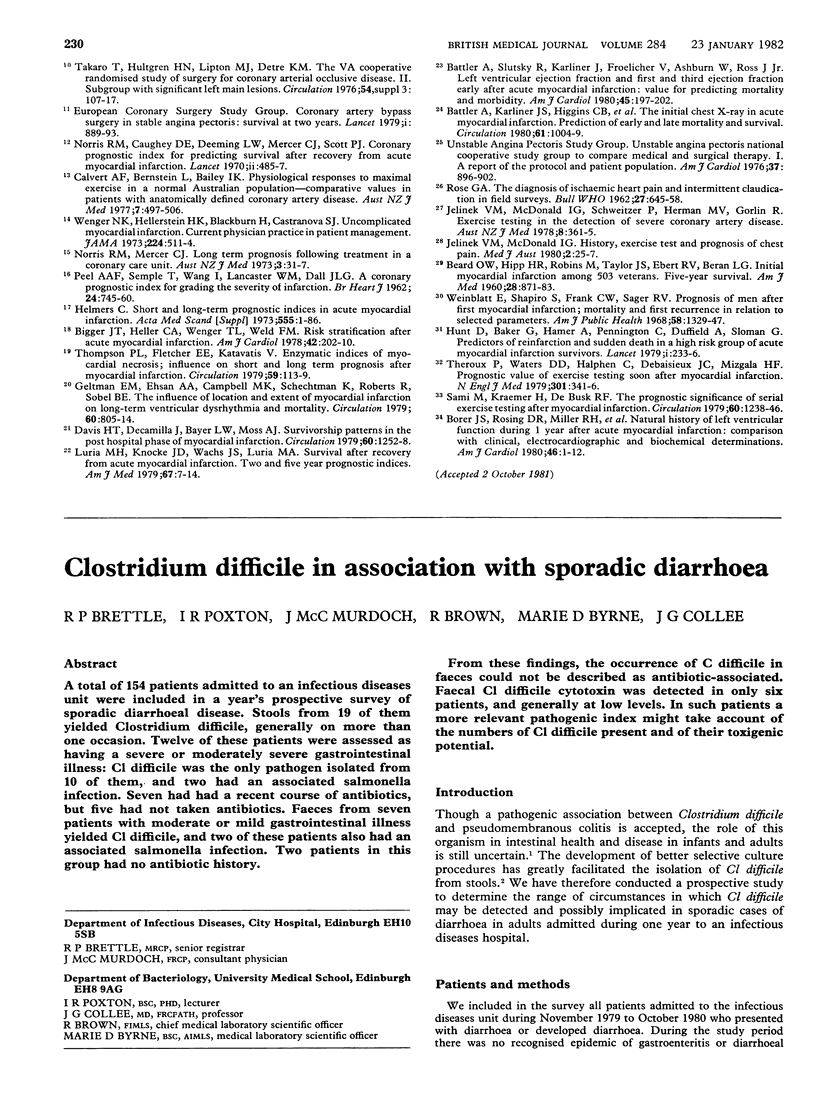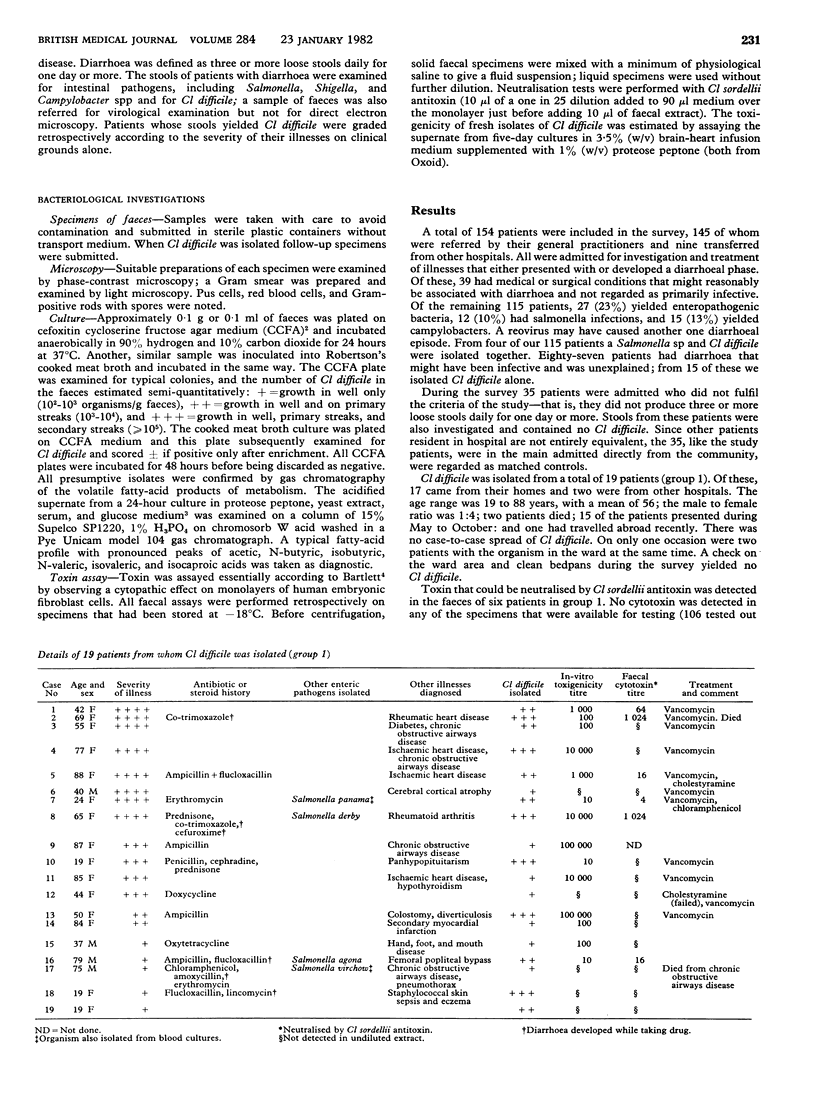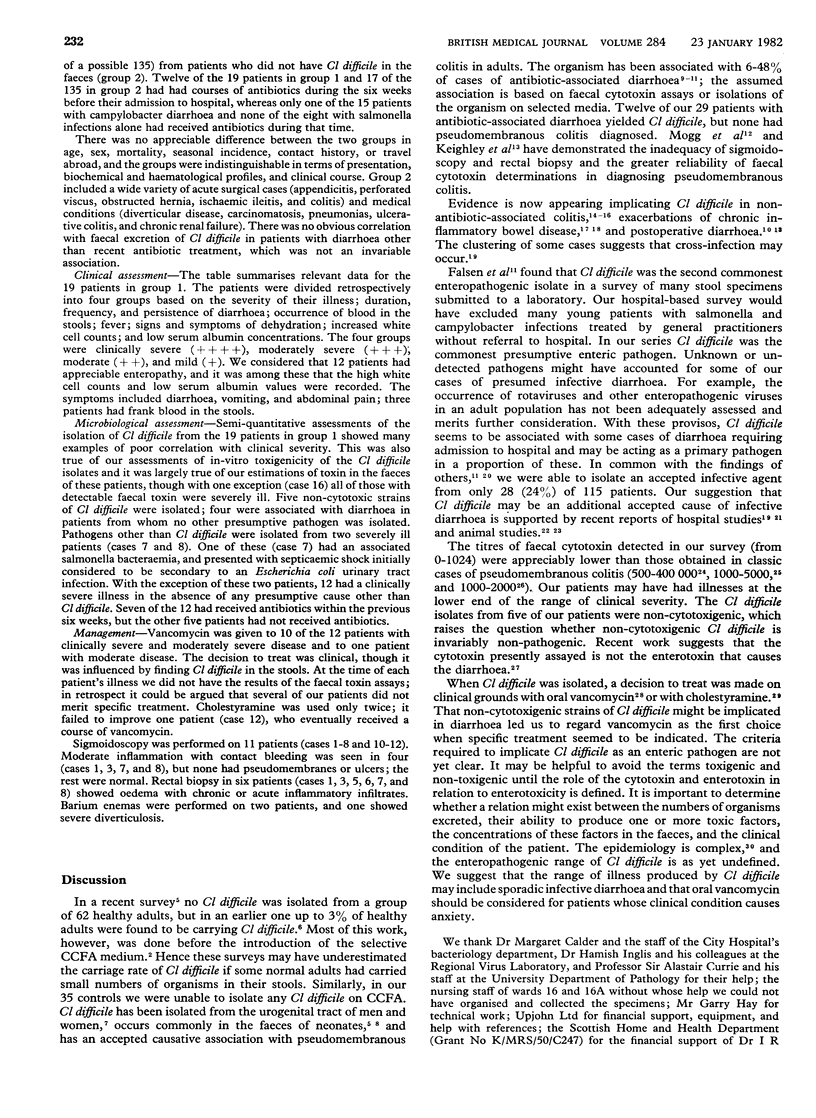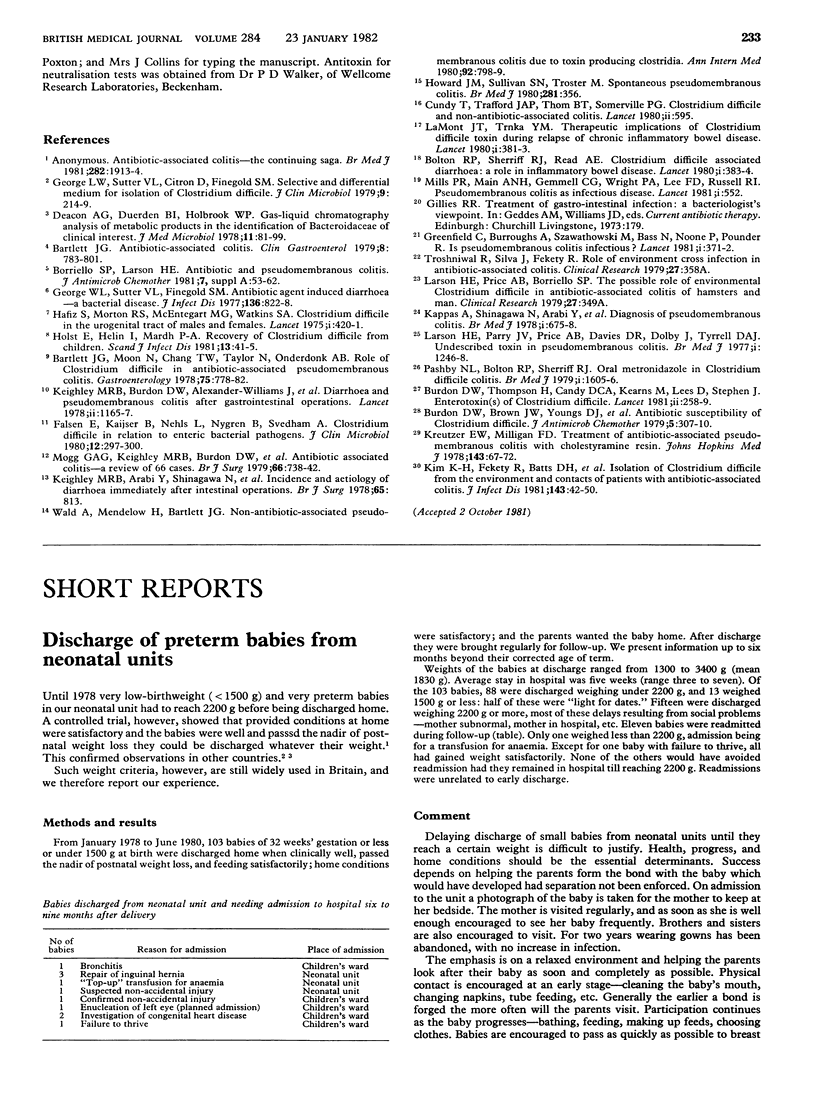Abstract
A total of 154 patients admitted to an infectious diseases unit were included in a year's prospective survey of sporadic diarrhoeal disease. Stools from 19 of them yielded Clostridium difficile, generally on more than one occasion. Twelve of these patients were assessed as having a severe or moderately severe gastrointestinal illness: Cl difficile was the only pathogen isolated from 10 of them, and two had an associated salmonella infection. Seven had had a recent course of antibiotics, but five had not taken antibiotics. Faeces from seven patients with moderate or mild gastrointestinal illness yielded Cl difficile, and two of these patients also had an associated salmonella infection. Two patients in this group had no antibiotic history. From these findings, the occurrence of C difficile in faeces could not be described as antibiotic-associated. Faecal Cl difficile cytotoxin was detected in only six patients, and generally at low levels. In such patients a more relevant pathogenic index might take account of the numbers of Cl difficile present and of their toxigenic potential.
Full text
PDF



Selected References
These references are in PubMed. This may not be the complete list of references from this article.
- Bartlett J. G. Antibiotic-associated colitis. Clin Gastroenterol. 1979 Sep;8(3):783–801. [PubMed] [Google Scholar]
- Bartlett J. G., Moon N., Chang T. W., Taylor N., Onderdonk A. B. Role of Clostridium difficile in antibiotic-associated pseudomembranous colitis. Gastroenterology. 1978 Nov;75(5):778–782. [PubMed] [Google Scholar]
- Bolton R. P., Sherriff R. J., Read A. E. Clostridium difficile associated diarrhoea: a role in inflammatory bowel disease? Lancet. 1980 Feb 23;1(8165):383–384. doi: 10.1016/s0140-6736(80)90940-x. [DOI] [PubMed] [Google Scholar]
- Burdon D. W., Brown J. D., Youngs D. J., Arabi Y., Shinagawa N., Alexander-Williams J., Keighley M. R., George R. H. Antibiotic susceptibility of Clostridium difficile. J Antimicrob Chemother. 1979 May;5(3):307–310. doi: 10.1093/jac/5.3.307. [DOI] [PubMed] [Google Scholar]
- Burdon D. W., Thompson H., Candy D. C., Kearns M., Lees D., Stephen J. Enterotoxin(s) of Clostridium difficile. Lancet. 1981 Aug 1;2(8240):258–259. doi: 10.1016/s0140-6736(81)90507-9. [DOI] [PubMed] [Google Scholar]
- Compston J. E., Horton L. W., Laker M. F., Ayers A. B., Woodhead J. S., Bull H. J., Gazet J. C., Pilkington T. R. Bone disease after jejuno-ileal bypass for obesity. Lancet. 1978 Jul 1;2(8079):1–4. doi: 10.1016/s0140-6736(78)91318-1. [DOI] [PubMed] [Google Scholar]
- Cundy T., Trafford J. A., Thom B. T., Somerville P. G. Clostridium difficile and non-antibiotic-associated colitis. Lancet. 1980 Sep 13;2(8194):595–595. doi: 10.1016/s0140-6736(80)92033-4. [DOI] [PubMed] [Google Scholar]
- Deacon A. G., Duerden B. I., Holbrook W. P. Gas-lipuid chromatographic analysis of metabolic products in the identification of bacteroidaceae of clinical interest. J Med Microbiol. 1978 May;11(2):81–99. doi: 10.1099/00222615-11-2-81. [DOI] [PubMed] [Google Scholar]
- Falsen E., Kaijser B., Nehls L., Nygren B., Svedhem A. Clostridium difficile in relation to enteric bacterial pathogens. J Clin Microbiol. 1980 Sep;12(3):297–300. doi: 10.1128/jcm.12.3.297-300.1980. [DOI] [PMC free article] [PubMed] [Google Scholar]
- George W. L., Sutter V. L., Citron D., Finegold S. M. Selective and differential medium for isolation of Clostridium difficile. J Clin Microbiol. 1979 Feb;9(2):214–219. doi: 10.1128/jcm.9.2.214-219.1979. [DOI] [PMC free article] [PubMed] [Google Scholar]
- George W. L., Sutter V. L., Finegold S. M. Antimicrobial agent-induced diarrhea--a bacterial disease. J Infect Dis. 1977 Dec;136(6):822–828. doi: 10.1093/infdis/136.6.822. [DOI] [PubMed] [Google Scholar]
- Greenfield C., Burroughs A., Szawathowski M., Bass N., Noone P., Pounder R. Is pseudomembranous colitis infectious? Lancet. 1981 Feb 14;1(8216):371–372. doi: 10.1016/s0140-6736(81)91683-4. [DOI] [PubMed] [Google Scholar]
- Hafiz S., McEntegart M. G., Morton R. S., Waitkins S. A. Clostridium defficiel in the urogenital tract of males and females. Lancet. 1975 Feb 22;1(7904):420–421. doi: 10.1016/s0140-6736(75)91489-0. [DOI] [PubMed] [Google Scholar]
- Holst E., Helin I., Mårdh P. A. Recovery of Clostridium difficile from children. Scand J Infect Dis. 1981;13(1):41–45. doi: 10.1080/00365548.1981.11690365. [DOI] [PubMed] [Google Scholar]
- Howard J. M., Sullivan S. N., Troster M. Spontaneous pseudomembranous colitis. Br Med J. 1980 Aug 2;281(6236):356–356. doi: 10.1136/bmj.281.6236.356. [DOI] [PMC free article] [PubMed] [Google Scholar]
- Kappas A., Shinagawa N., Arabi Y., Thompson H., Burdon D., Dimock F., George R. H., Alexander-Williams J., Keighley M. R. Diagnosis of pseudomembranous colitis. Br Med J. 1978 Mar 18;1(6114):675–678. doi: 10.1136/bmj.1.6114.675. [DOI] [PMC free article] [PubMed] [Google Scholar]
- Kim K. H., Fekety R., Batts D. H., Brown D., Cudmore M., Silva J., Jr, Waters D. Isolation of Clostridium difficile from the environment and contacts of patients with antibiotic-associated colitis. J Infect Dis. 1981 Jan;143(1):42–50. doi: 10.1093/infdis/143.1.42. [DOI] [PubMed] [Google Scholar]
- Kreutzer E. W., Milligan F. D. Treatment of antibiotic-associated pseudomembranous colitis with cholestyramine resin. Johns Hopkins Med J. 1978 Sep;143(3):67–72. [PubMed] [Google Scholar]
- LaMont J. T., Trnka Y. M. Therapeutic implications of Clostridium difficile toxin during relapse of chronic inflammatory bowel disease. Lancet. 1980 Feb 23;1(8165):381–383. doi: 10.1016/s0140-6736(80)90939-3. [DOI] [PubMed] [Google Scholar]
- Langham P. Parental consent: its justification and limitations. Clin Res. 1979 Dec;27(5):349–358. [PubMed] [Google Scholar]
- Larson H. E., Parry J. V., Price A. B., Davies D. R., Dolby J., Tyrrell D. A. Undescribed toxin in pseudomembranous colitis. Br Med J. 1977 May 14;1(6071):1246–1248. doi: 10.1136/bmj.1.6071.1246. [DOI] [PMC free article] [PubMed] [Google Scholar]
- Mills P. R., Main A. N., Gemmell C. G., Wright P. A., Lee F. D., Russell R. I. Pseudomembranous colitis as infectious disease. Lancet. 1981 Mar 7;1(8219):552–552. doi: 10.1016/s0140-6736(81)92879-8. [DOI] [PubMed] [Google Scholar]
- Mogg G. A., Keighley M. R., Burdon D. W., Alexander-Williams J., Youngs D., Johnson M., Bentley S., George R. H. Antibiotic-associated colitis--a review of 66 cases. Br J Surg. 1979 Oct;66(10):738–742. doi: 10.1002/bjs.1800661017. [DOI] [PubMed] [Google Scholar]
- Pashby N. L., Bolton R. P., Sherriff R. J. Oral metronidazole in Clostridium difficile colitis. Br Med J. 1979 Jun 16;1(6178):1605–1606. doi: 10.1136/bmj.1.6178.1605. [DOI] [PMC free article] [PubMed] [Google Scholar]
- Wald A., Mendelow H., Bartlett J. G. Non-antibiotic-associated pseudomembranous colitis due to toxin-producing Clostridia. Ann Intern Med. 1980 Jun;92(6):798–799. doi: 10.7326/0003-4819-92-6-798. [DOI] [PubMed] [Google Scholar]


